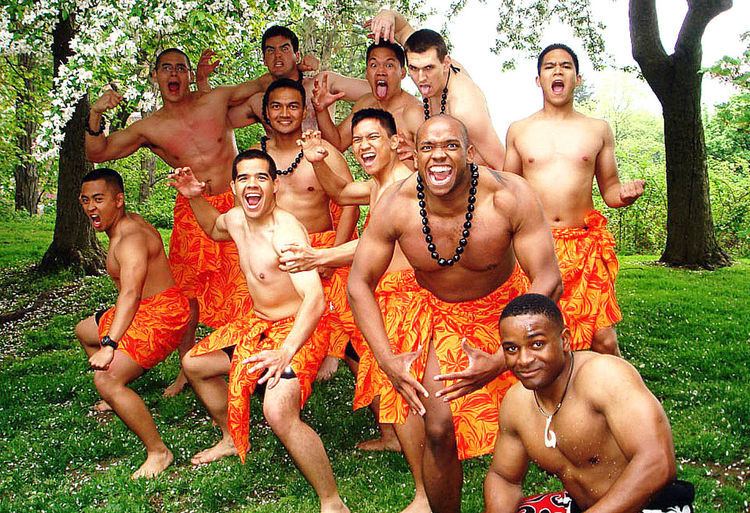Observed by United States Frequency Annual | Date May | |
 | ||
Asian Pacific American Heritage Month (APAHM), now officially proclaimed Asian American and Pacific Islander Heritage Month, takes place in May. It celebrates the culture, traditions, and history of Asian Americans and Pacific Islanders in the United States.
Contents
History
In June 1977 Reps. Frank Horton of New York and Norman Y. Mineta of California introduced a United States House of Representatives resolution to proclaim the first ten days of May as Asian-Pacific Heritage Week. A similar bill was introduced in the Senate a month later by Daniel Inouye and Spark Matsunaga. "The month of May was chosen to commemorate the immigration of the first Japanese to the United States on May 7, 1843, and to mark the anniversary of the completion of the transcontinental railroad on May 10, 1869. The majority of the workers who laid the tracks were Chinese immigrants." President Jimmy Carter signed a joint resolution for the celebration on October 5, 1978.
House Resolution 540
"A joint resolution authorizing the President to proclaim annually a week during the first 10 days in May as Pacific/Asian American Heritage Week." This resolution as well as Senate Joint Resolution 72 did not pass through however, did lead to the passing of Rep. Horton's House Joint Resolution 1007 which passed through both the House and the Senate and ultimately signed by President Jimmy Carter on October 5, 1978 to become Public Law 95-419. In 1990, George H.W. Bush signed a bill passed by Congress to extend Asian-American Heritage Week to a month; May was officially designated as Asian-Pacific American Heritage Month two years later. On May 1, 2009 President Obama issued a Presidential Proclamation which recalls the challenges faced by Asian Americans and Pacific Islanders and celebrates their great and significant contributions to our society.
Phillippine-American War
José B. Nísperos, PVT
Peacetime
Telesforo de la Crux Trinidad, Fireman 2nd Class (only Medal of Honor issued in peacetime).
World War II
Jose Calugas, SR, CPT Rudolph B. Davila, SSG Barney Fushimi Hajiro, PVT Mikio Hasemoto, PVT Joe J. Hayashi, SGT Shizuya Hayashi, PVT Daniel K. Inouye, 2LT Yeiki Kobashigawa, TSGT Robert T. Kuroda, SSG Kaoru Moto, PFC Sadao S. Munemori, PFC Kiyoshi k. Muranaga, PFC Masato Nakae, PVT Shinyei Nakamine, PVT William Kanzo Nakamura, PFC Joe M. Nishimoto, PFC Allan Masaharu Ohata, SGT James K. Okubo, TSGT Yukio Okutsu, TSGT Frank H. Ono, PFC Kazuo Otani, SSG George Taro “Joe” Sakato, PVT Ted “Tak” Tanouye, SGT Francis Brown Wai, CPT
Korean War
Hiroshi “Hershey” Miyamura, SSG Leroy A. Mendonca, SGT (youngest MOH recipient) Herbert K. Pilila’au, PFC Anthony T. Kaho'ohanohano, PFC
Vietnam War
Terry Teruo Kawamura, CPL Elmelindo Rodrigues Smith, SFC Rodney Jamus Takahashi Yano, SFC
Congressional Asian Pacific American Caucus
Co-Founded by Norman Y. Mineta on May 16, 1994, the caucus is made up of members of Congress from Asian and Pacific Islander decent or are advocates dedicated to the community, striving to promote well-being.
Purpose
"To ensure that legislation passed by the United States Congress, to the greatest extent possible, provides for the full participation of Asian Americans and Pacific Islanders and reflects the concerns and needs of the Asian American and Pacific Islander communities;
To educate other Members of Congress about the history, contributions and concerns of Asian American and Pacific Islanders;
To work with other Members and Caucuses to protect and advance the civil and constitutional rights of all Americans;
To establish policies on legislation and issues relating to persons of Asian and/or Pacific Islands ancestry who are citizens or nationals of, residents of, or immigrants to, the United States, its territories and possessions; and
To provide a structure to coordinate the efforts, and enhance the ability, of the Asian American and Pacific Islander Members of Congress to accomplish those goals."
Traditions
Asian Pacific and Asian Americans of all ethnicities and languages come together to celebrate their heritage through many activities such as dancing, sharing traditional meals, observing and appreciating their rich history. Many more diverse beliefs and practices come with the already diversified Asian American community. Although there are so many different religions, traditions, and practices, all Asian Americans share the same idea of helping one another adjust to living in the U.S. and all the problems and affairs that come along with it. From everyday tasks like asking for directions and ordering food to more difficult situations like financial advice or finding housing; Asian Americans have a tough time adjusting to American lifestyle, especially if they were not born here learning the language.
Icons
Asian American actors, actresses and celebrities play a major role in the adjusting to the American lifestyle. They start trends that their kinfolk alike begin to follow along like the kanji tattoo sported by former Seattle Mariners, American League Rookie of the Year and Most Valuable Player Ichiro Suzuki. Furthermore, actresses like Lucy Liu take on major female roles in movies that send a message of hope and progress in Asian American eyes. Icons like Ichiro and Lucy bring about a sense of togetherness and comfortability for Asian Americans.
Events
During APAHM, communities celebrate the achievements and contributions of Asian and Pacific Americans with community festivals, government-sponsored activities and educational activities for students.
Pan-Asian
Northeast and East:
West Coast:
South and Southeast:
Midwest:
